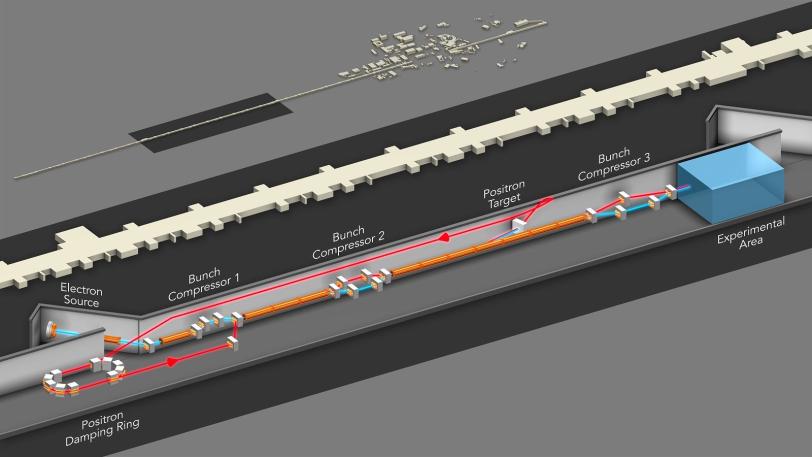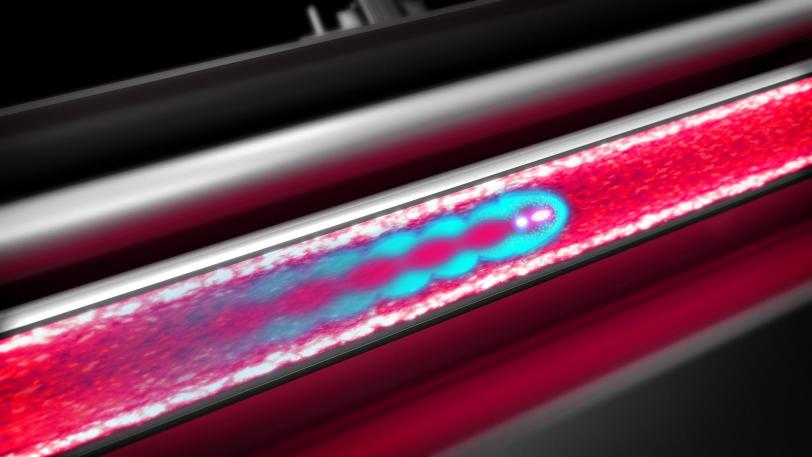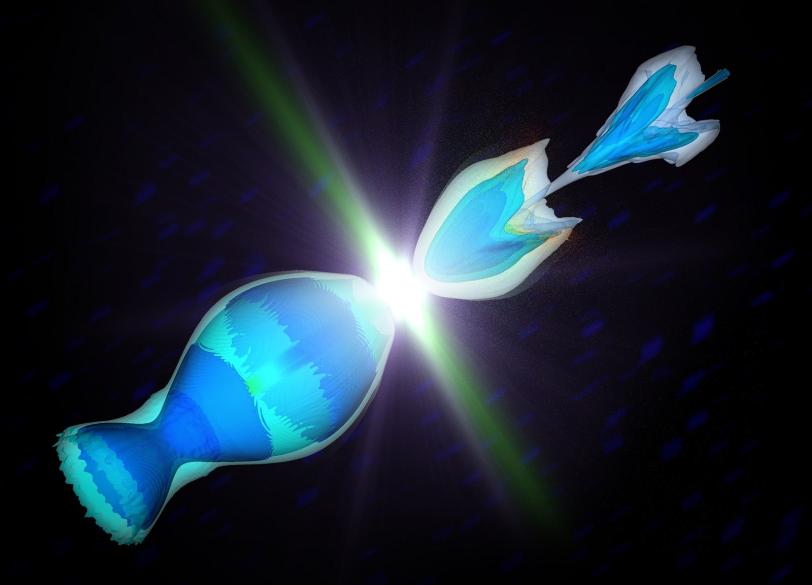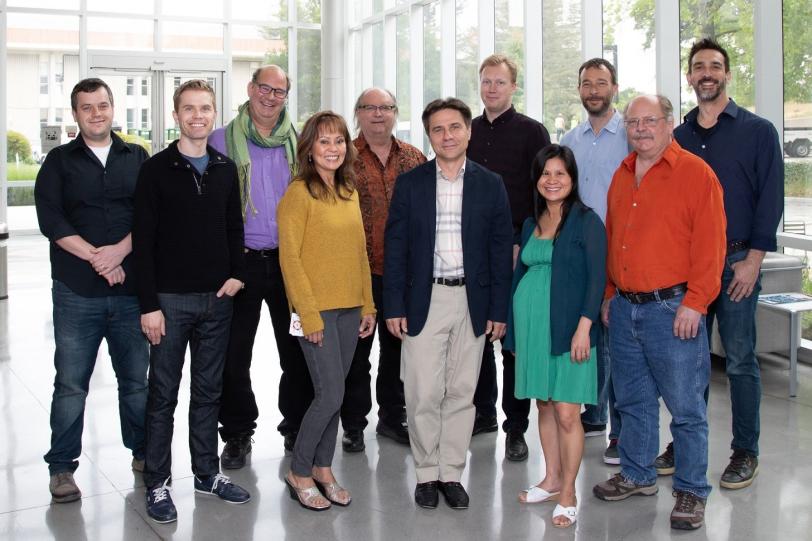Work Begins on New SLAC Facility for Revolutionary Accelerator Science
The goal: develop plasma technologies that could shrink future accelerators up to 1,000 times, potentially paving the way for next-generation particle colliders and powerful light sources.
Menlo Park, Calif. — The Department of Energy’s SLAC National Accelerator Laboratory has started to assemble a new facility for revolutionary accelerator technologies that could make future accelerators 100 to 1,000 times smaller and boost their capabilities.
The project is an upgrade to the Facility for Advanced Accelerator Experimental Tests (FACET), a DOE Office of Science user facility that operated from 2011 to 2016. FACET-II will produce beams of highly energetic electrons like its predecessor, but with even better quality. These beams will primarily be used to develop plasma acceleration techniques, which could lead to next-generation particle colliders that enhance our understanding of nature’s fundamental particles and forces and novel X-ray lasers that provide us with unparalleled views of ultrafast processes in the atomic world around us.
FACET-II will be a unique facility that will help keep the U.S. at the forefront of accelerator science, said SLAC’s Vitaly Yakimenko, project director. “Its high-quality beams will enable us to develop novel acceleration methods,” he said. “In particular, those studies will bring us close to turning plasma acceleration into actual scientific applications.”

The DOE has now approved the $26 million project (Critical Decisions 2 and 3). The new facility, which is expected to be completed by the end of 2019, will also operate as an Office of Science user facility – a federally sponsored research facility for advanced accelerator research available on a competitive, peer-reviewed basis to scientists from around the world.
“As a strategically important national user facility, FACET-II will allow us to explore the feasibility and applications of plasma-driven accelerator technology,” said James Siegrist, associate director of the High Energy Physics (HEP) program of DOE’s Office of Science, which stewards advanced accelerator R&D in the U.S. for the development of applications in science and society. “We’re looking forward to seeing the groundbreaking science in this area that FACET-II promises, with the potential for significant reduction of the size and cost of future accelerators, including free-electron lasers and medical accelerators.”
Bruce Dunham, head of SLAC’s Accelerator Directorate, said, “Our lab was built on accelerator technology and continues to push innovations in the field. We’re excited to see FACET-II move forward.”
Surfing the Plasma Wake
The new facility will build on the successes of FACET, where scientists already demonstrated that the plasma technique can very efficiently boost the energy of electrons and their antimatter particles, positrons. In this method, researchers send a bunch of very energetic particles through a hot ionized gas, or plasma, creating a plasma wake for a trailing bunch to “surf” on and gain energy.

In conventional accelerators, particles draw energy from a radiofrequency field inside metal structures. However, these structures can only support a limited energy gain per distance before breaking down. Therefore, accelerators that generate very high energies become very long, and very expensive. The plasma wakefield approach promises to break new ground. Future plasma accelerators could, for example, unfold the same acceleration power as SLAC’s historic 2-mile-long copper accelerator (linac) in just a few meters.
Researchers will use FACET-II for crucial developments before plasma accelerators can become a reality. “We need to show that we’re able to preserve the quality of the beam as it passes through plasma,” said SLAC’s Mark Hogan, FACET-II project scientist. “High-quality beams are an absolute requirement for future applications in particle and X-ray laser physics.”
The FACET-II facility is currently funded to operate with electrons, but its design allows adding the capability to produce and accelerate positrons later – a step that would enable the development of plasma-based electron-positron particle colliders for particle physics experiments.

Another important objective is the development of novel electron sources that could lead to next-generation light sources, such as brighter-than-ever X-ray lasers. These powerful discovery machines provide scientists with unprecedented views of the ever-changing atomic world and open up new avenues for research in chemistry, biology and materials science.
Other science goals for FACET-II include compact wakefield accelerators that use certain electrical insulators (dielectrics) instead of plasma, as well as diagnostics and computational tools that will accurately measure and simulate the physics of the new facility’s powerful electron beams. Science goals are being developed with regular input from the FACET user community.
“The approval for FACET-II is an exciting milestone for the science community,” said Chandrashekhar Joshi, a researcher from the University of California, Los Angeles, and longtime collaborator of SLAC’s plasma acceleration team. “The facility will push the boundaries of accelerator science, discover new and unexpected physics and substantially contribute to the nation’s coordinated effort in advanced accelerator R&D.”
Fast Track to First Experiments
To complete the facility, crews will install an electron source and magnets to compress electron bunches, as well as new shielding, said SLAC’s Carsten Hast, FACET-II technical director. “We’ll also upgrade the facility’s control systems and install tools to analyze the beam properties.”
FACET-II will use one kilometer (one-third) of the SLAC linac – sending electrons from the source at one end to the experimental area at the other end – to generate an electron beam with an energy of 10 billion electronvolts that will drive the facility’s versatile research program.
FACET-II has issued its first call for proposals for experiments that will run when the facility goes online in 2020.
“The project team has done an outstanding job in securing DOE approval for the facility,” said DOE’s Hannibal Joma, federal project director for FACET-II. “We’ll now deliver the project on time for the user program at SLAC.”
SLAC’s Selina Green, project manager, said, “After two years of very hard work, it’s very exciting to see the project finally come together. Thanks to the DOE’s continued support we’ll soon be able to open FACET-II for groundbreaking new science.”

For more information, please visit the FACET-II Website
-Written by Manuel Gnida
For questions or comments, contact the SLAC Office of Communications at communications@slac.stanford.edu.
SLAC is a multi-program laboratory exploring frontier questions in photon science, astrophysics, particle physics and accelerator research. Located in Menlo Park, California, SLAC is operated by Stanford University for the U.S. Department of Energy Office of Science. To learn more, please visit www.slac.stanford.edu.
SLAC National Accelerator Laboratory is supported by the Office of Science of the U.S. Department of Energy. The Office of Science is the single largest supporter of basic research in the physical sciences in the United States, and is working to address some of the most pressing challenges of our time. For more information, please visit science.energy.gov.





